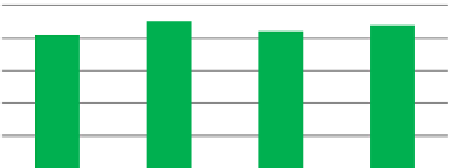Biomedical Engineering Reference
In-Depth Information
with a thin quilt, the detection accuracy was 100% (N=24) in the side-lying position,
and it was 100% (N=24) in the supine position. Besides, while the user slept with no
quilt, the detection accuracy was 95.8% (N=24) in the side-lying position, and it was
100% (N=24) in the supine position.
100%
80%
88.0%
90.4%
84.1%
60%
81.9%
40%
20%
0%
Side lying
Supine
Side lying
Supine
Sleep without quilt
Sleep with a thin quilt
Fig. 7.
Results of breath measurement in experiment I
4.2
Experiment I I: Realistic Overnight-Sleep Monitoring
Experimental Design.
The experiment was conducted to ensure that the system could
monitor the realistic overnight-sleep conditions accurately. A male participant (28
years-old) volunteered to participate in this experiment. The same as the first experi-
ment, the breathing sensor (RIP) was used to measure the breathing conditions as the
ground truth. In addition, an actigraphy was used to measure the movement of the
non-dominant hand while sleeping. There was only one limitation that the participant
was asked to lie on the pillow. In this experiment, the participant was asked to partici-
pate in a ten-day overnight-sleep monitoring experiment. The experiment did not
specify the time to go to the bed, the time to getting up, and the totally sleeping time.
Besides, we required participants to sleep with a thin quilt for five days, and to sleep
with no quilt for another five days. Participant's breathing rate, body movement, and
sleep position were monitored by our method and compared to the RIP and actigra-
phy. Fig. 8 shows one of a realistic overnight-sleep monitoring results in day 3. Fig.
8a shows the measurement results of breathing rate. Red curve indicates the mea-
surement results of RIP system, and the blue curve indicates the measurement results
of our system. Lower part of Fig. 8a shows the sleep positions we detected (blue) and
real condition (red). Fig. 8b shows the movement level detected by an actigraphy, and
Fig. 8c shows the movement level detected by our system. In this day, the participant
slept with a thin quilt from 1:30 AM to 4:53 AM.
Experimental Results.
The same with experiment I, the sleep measurement were
divided into four different conditions, including two sleep positions (side-lying and
supine) and two sleep circumstances (sleep with a thin quilt and sleep with no quilt).
Totally, the participant slept 42 hours in ten nights. Following shows the experimental
results. In the circumstance of sleeping with no quilt, the measurement accuracy of
head detection was 89.4% (SD = 0.14) in the side-lying position and it was 99.9%
(SD = 0.0007) in the supine position. Moreover, the measurement accuracy of torso














Search WWH ::

Custom Search